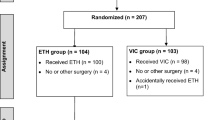Abstract
Introduction and hypothesis
This investigation describes the feasibility and outcome of vaginal paravaginal repair (VPVR) performed using the Capio™ suture-capturing device.
Methods
This prospective study included 36 women with paravaginal fascial defects, symptomatic stage II to IV anterior vaginal wall prolapse, and uterine prolapse equal or more than stage 2. VPVR was performed using the Capio device. In addition, anterior colporrhaphy, posterior colporrhaphy, and vaginal hysterectomy were performed.
Results
The mean time required to perform the VPVR was 12.9 min (range, 11–18 min). The median blood loss during the VPVR was 35 ml (range, 20–65 ml). There were no major intraoperative complications. At 2-year follow-up, the rate of recurrent anterior vaginal wall prolapse (stage ≥2) was 8.6%.
Conclusions
VPVR performed using the Capio device is associated with minimal dissection of the tissues, blood loss, and operating time and has low recurrence rate at 2-year follow-up.

Similar content being viewed by others
References
Hendrix SL, Clark A, Nygaard I, Aragaki A, Barnabei V, McTiernan A (2002) Pelvic organ prolapse in the Women’s Health Initiative: gravity and gravidity. Am J Obstet Gynecol 186:1160–1166
Chen L, Ashton-Miller JA, DeLancey JO (2009) A 3D finite element model of anterior vaginal wall support to evaluate mechanisms underlying cystocele formation. J Biomech 42:1371–1377
White GR (1909) Cystocele. JAMA 853:1707–1710
Richardson AC, Lyon JB, Williams NL (1976) A new look at pelvic relaxation. Am J Obstet Gynecol 126:568–573
Richardson AC, Saye WB, Miklos JR (1997) Repairing paravaginal defects laparoscopically. Contemp Obstet Gynecol 42:125–130
White GR (1912) An anatomic operation for the cure of cistocele. Am J Obstet Dis Women Children 126:568
Shull BL, Benn SJ, Kuehl TJ (1994) Surgical management of prolapse of the anterior vaginal segment: an analysis of support defects, operative morbidity, and anatomic outcome. Am J Obstet Gynecol 171:1429–1436
Grody MHT, Nyirjesy P, Kelley LM, Millar L (1995) Paraurethral fascial sling urethropexy and vaginal paravaginal defects cystopexy in the correction of urethrovesical prolapse. Int Urogynecol J Pelvic Floor Dysfunct 6:80–85
Elkins TE, Chesson RR, Videla F, Menefee S, Yordan R, Barksdale PA (2000) Transvaginal paravaginal repair: a useful adjunctive procedure in pelvic relaxation surgery. J Pelvic Surg 6:11–15
Mallipeddi PK, Steele AC, Kohli N, Karram MM (2001) Anatomic and functional outcome of vaginal paravaginal repair in the correction of anterior vaginal wall prolapse. Int Urogynecol J Pelvic Floor Dysfunct 12:83–88
Young SB, Daman JJ, Bony LG (2001) Vaginal paravaginal repair: one-year outcomes. Am J Obstet Gynecol 185:1360–1366
Viana R, Colaço J, Vieira A, Gonçalves V, Retto H (2006) Cystocele—vaginal approach to repairing paravaginal fascial defects. Int Urogynecol J Pelvic Floor Dysfunct 17:621–623
Ward RM, Sung VW, Clemons JL, Myers DL (2007) Vaginal paravaginal repair with an AlloDerm graft: long-term outcomes. Am J Obstet Gynecol 197:670.e1–5
Novi JM, Mulvihil BH, Arya L (2009) Vaginal paravaginal repair using porcine or human cadaveric dermal implant: a survival analysis. Int Surg 94:88–94
Reid RI, Luo K (2011) Site-specific prolapse surgery. II. Vaginal paravaginal repair augmented with either synthetic mesh or remodelling xenograft. Int Urogynecol J Pelvic Floor Dysfunct 22:601–609
Maher C, Baessler K (2006) Surgical management of anterior vaginal wall prolapse: an evidencebased literature review. Int Urogynecol J Pelvic Floor Dysfunct 17:195–201
Richardson AC, Edmonds PB, Williams NL (1981) Treatment of stress urinary incontinence due to paravaginal fascial defect. Obstet Gynecol 57:357–362
Bruce RG, El-Galley RE, Galloway NT (1999) Paravaginal defect repair in the treatment of female stress urinary incontinence and cystocele. Urology 54:647–651
Scotti RJ, Garely AD, Greston WM, Flora RF, Olson TR (1998) Paravaginal repair of lateral vaginal wall defects by fixation to the ischial periosteum and obturator membrane. Am J Obstet Gynecol 179:1436–1445
Shull BL, Baden WF (1989) A six-year experience with paravaginal defect repair for stress urinary incontinence. Am J Obstet Gynecol 160:1432–1439
Reid RI, You H, Luo K (2011) Site-specific prolapse surgery. I. Reliability and durability of native tissue paravaginal repair. Int Urogynecol J Pelvic Floor Dysfunct 22:591–599
Miklos JR, Kohli N (2000) Laparoscopic paravaginal repair plus burch colposuspension: review and descriptive technique. Urology 56:64–69
Behnia-Willison F, Seman EI, Cook JR, O’Shea RT, Keirse MJ (2007) Laparoscopic paravaginal repair of anterior compartment prolapse. J Minim Invasive Gynecol 14:475–480
Shippey SH, Quiroz LH, Sanses TV, Knoepp LR, Cundiff GW, Handa VL (2010) Anatomic outcomes of abdominal sacrocolpopexy with or without paravaginal repair. Int Urogynecol J Pelvic Floor Dysfunct 21:279–283
Ouzaid I, Ben Rhouma S, de Tayrac R, Costa P, Prudhomme M, Delmas V (2010) Mini-invasive posterior sacrospinous ligament fixation using the CAPIO needle driver: an anatomical study. Prog Urol 20:515–519
Haylen BT, de Ridder D, Freeman RM et al (2010) An International Urogynecological Association (IUGA)/International Continence Society (ICS) joint report on the terminology for female pelvic floor dysfunction. Int Urogynecol J Pelvic Floor Dysfunct 21:5–26
Nieboer TE, Johnson N, Lethaby A et al (2009) Surgical approach to hysterectomy for benign gynaecological disease. Cochrane Database Syst Rev 3:CD003677
Minassian VA, Stewart WF, Wood GC (2008) Urinary incontinence in women: variation in prevalence estimates and risk factors. Obstet Gynecol 111:324–331
Ogah J, Cody JD, Rogerson L (2009) Minimally invasive synthetic suburethral sling operations for stress urinary incontinence in women. Cochrane Database Syst Rev 4:CD006375
Rehman H, Bezerra CC, Bruschini H, Cody JD (2011) Traditional suburethral sling operations for urinary incontinence in women. Cochrane Database Syst Rev 1:CD001754
Conflicts of interest
None.
Author information
Authors and Affiliations
Corresponding author
Electronic supplementary material
Below is the link to the electronic supplementary material.
ESM 1
For review (JPEG 91.4 kb)
Rights and permissions
About this article
Cite this article
Leone Roberti Maggiore, U., Ferrero, S., Mancuso, S. et al. Feasibility and outcome of vaginal paravaginal repair using the Capio suture-capturing device. Int Urogynecol J 23, 341–347 (2012). https://doi.org/10.1007/s00192-011-1566-1
Received:
Accepted:
Published:
Issue Date:
DOI: https://doi.org/10.1007/s00192-011-1566-1



